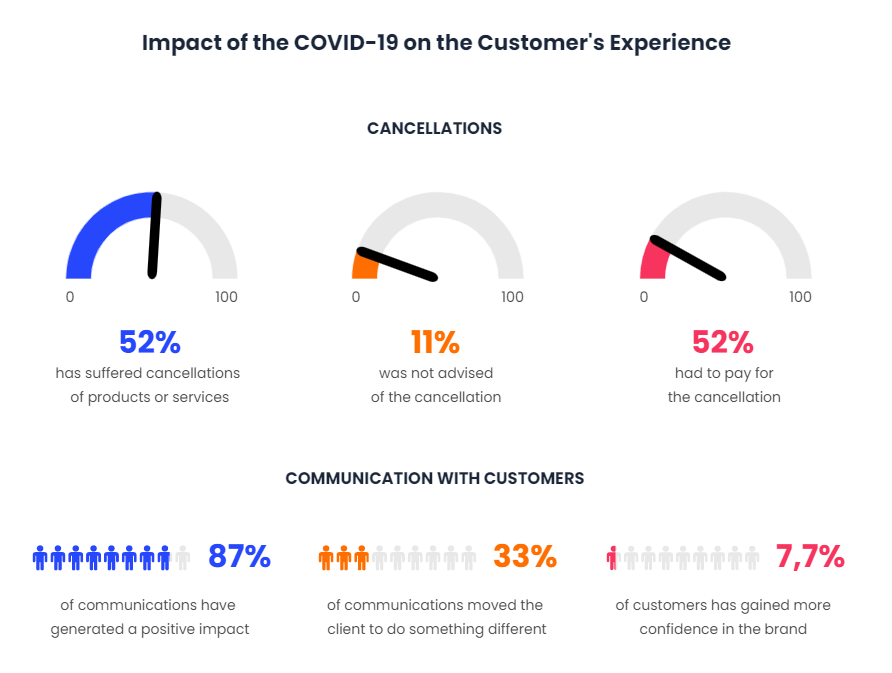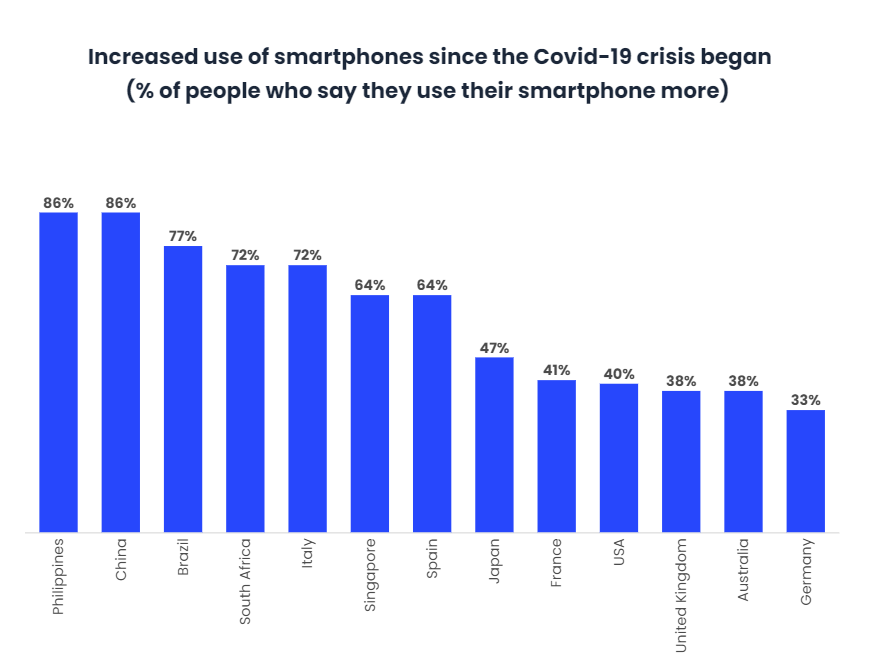Redefining the Customer Experience in Covid-19 Times

All relationships have an emotional component, and that is true for the connection between people and brands. A business relationship with customers is built over time, is nurtured by experiences along the customer’s journey with many points of contact both physically and online, is based on expectations and is confirmed by repeated interactions.
A crisis puts the strengths and weaknesses of that relationship in the spotlight. And the Coronavirus pandemic is no ordinary crisis.
Nearly a third of the world’s population has to stay at home as a result of the pandemic. The implications of this for many brands is that they are on the verge of collapse. With an increase in the number of infections, there is no date to return to normal life.
This confinement, which is forcing most people to become physically separated from their friends, family, workplaces, and favorite places, requires organizations to adapt to a digital or remote way of doing business and is dramatically altering people’s daily experiences.
How is this crisis affecting the CX?
With the Coronavirus outbreak, busy Customer Experience teams around the world have to adapt quickly amid product and service cancellations, market volatility, and increased uncertainty. Every week, the world changes, and business simply isn’t business as usual. Most teams serving customers are doing so from home, putting additional pressure on their ability to respond to customers effectively. For many, that means learning and adapting as they go.
All customers have had to modify their behavior. But brands have also had to adapt, and this has had a direct impact on the Customer Experience (CX) – in fact, 30% of customers have reviewed their regular expenses and bills, with the intention of reducing them.

The Coronavirus crisis is bringing unprecedented social change, and from a purely commercial perspective, is already affecting customer travel, their expectations and the ability of brands to meet them.
How to manage the Customer Experience during the Covid-19
Confinement is rapidly altering consumers’ expectations, activities and motivations. This will impact the customer’s perception of different brands in different ways, and has forced a rethink of what customer care means.
Suddenly, the examination of customer travel and satisfaction metrics to inform what customers want has given way to an acute urgency to address what they need. Particularly in times of crisis, a customer’s interaction with a company can trigger an immediate and persistent effect on trust and loyalty.
As a result, what matters most to customers at this time may be changing. Brands with the best price, the best product or the most memorable marketing campaign may not have an advantage compared to those that exhibit emotional intelligence and communicate with care, honesty and empathy, and as a result generate trust. In times of crisis, people want to be seen and understood, and are extremely sensitive to tone and motive.
Hand in hand with this perspective, the following CX practices can frame short-term responses, build resilience, and prepare client companies for success in the days following Coronavirus.
Focus on care and connection
The Customer Experience during the COVID-19 crisis is all about one thing: empathetic engagement. To show true empathy, you have to reach out before customers feel stressed and worried. You must take time to understand their mindset and take clear action to meet their needs before they even express them. That’s what empathic engagement is all about.
There is a time and a place for everything, and now is the time to be humane and show humanity. To that end, Emotional Intelligence (the ability to use emotional information to guide thought and behavior) is a good skill that companies should rely on as the COVID-19 crisis continues to affect the client base.
Clients need immutable realities at this time. Knowing that their favorite brands are alive, well, and that brings a certain sense of calm. Still, the experiences themselves must be different if the company is to remain relevant at this time. That can mean increased spending on social responsibility and decreased focus on sales.
If a brand demonstrates to its customers that it is doing everything in its power to protect and serve them rather than seeking profit, and understands that this is not the time for business as usual, customers will be much more forgiving when mistakes occur and will be more loyal to the brand.
The importance of informing
Probably the most important part of managing the Customer Experience during this time is making sure that the brand is being communicated clearly and quickly. Changed hours, updated delivery policy, a new way to reach customer service…, it’s important that customers feel connected and like they know what’s going on.
It’s good to communicate with concerned customers and provide them with all the information they demand, using agile and personalized daily communications to keep them updated, protected and positive.
The confined client must be placed at the center of the strategic plan. Address how clients can be helped to stay safe in this pandemic and address their concerns and fears. Also communicating what the brand does to ensure a safe service or shopping experience in physical locations can gain confidence (and business).
Attitudes and perceptions will change very quickly, so real-time monitoring and reporting will be essential.
Optimize the mobile experience
Being at home is driving smartphone use, especially among the younger generation. According to data collected between March 16 and 20 from 13 countries, 70% of people worldwide say they spend much more time using their smartphone since the COVID-19 crisis began, 80% in the case of Generation Z.

Therefore, if you have a web presence, you will want to make the Customer Experience on your smartphone as seamless as possible.
Focus on social networks
With social distancing and homeboundness, people are more engaged online than ever before, and there has been a significant increase in the use of social networks.
It has become a trend right now and companies need to use it to their advantage, especially if a business can’t function as usual, participating in social media is a great way to keep the brand active and still deliver value to customers, albeit in a different and new way. This is an opportunity to be visible and interact with customers in a less formal environment.
Increase and improve digital marketing
With around 3 billion people in their homes worldwide, the online world has become a good opportunity. That means that, instead of boosting sales, it would be a good time to increase and improve digital marketing.
Previously, it was common to send an email once a month to inform contacts about special offers, events or news of that month. But with circumstances changing at an unprecedented rate, the frequency with which brands communicate with their contacts has to change as well.
For example, before the lockdown, people were often too busy to read the full newsletters a brand sent out. Now, however, they are at home with time on their hands, so you could switch from a monthly newsletter to a weekly one or send short email campaigns on the fly if something important happens.
This is the perfect time to interact with these customers, talk to them and listen to their feedback.
When it comes to social media marketing, posting three times a week might have been enough, but now once a day is not too much, especially if you are changing what you have to offer almost daily.
There will be a before and after
The COVID-19 crisis will end at some point, but it is quite likely that consumer preferences and business models will change somewhat when all this happens:
- First of all, people will get used to working from home. Using Teams, Slack and Zoom and similar tools, personal productivity at home will increase rapidly.
- Second, COVID-19 will accelerate the shift from face-to-face interactions to all-digital communications. Online rather than in-store shopping will be the norm.
- Third, there will be stronger and more direct relationships with preferred brands. Consumer goods companies are choosing Direct to Consumer (D2C) digital channels over traditional retail channels.
- From now on, there will be deeper and more emotional personalized engagements with the chosen suppliers. Marketing experts know that emotionally engaged customers are twice as valuable as satisfied customers, and by 2025 it is predicted that 60% of major brands and retailers will improve customer engagement by detecting and managing emotions to influence purchases. Emotion technology is real and it’s happening.
In short, COVID-19 will accelerate the movement of digital omnicanal experiences to deeply impact relationships and behaviors at work and with providers.
Conclusions
COVID-19 will not disappear in the short or medium term. This problem, and everything that is affected, including unemployment, low consumer demand, etc., will last months, if not years. There is still time for businesses to proactively engage their customers, even if they have not yet begun.
Brands that take proactive steps to comfort customers and protect their financial security and confidence will gain a strong reputation, which will bring long-term benefits. The key is to listen and follow up on what they need, whether it’s good for the business or not right now.
Keep in mind that the impact of actions taken today will likely outlast the pandemic and define the loyalty people have to a brand and its products.
Now is also the time for Customer Experience (CX) leaders to position themselves at the forefront of the long-term changes in consumer behavior that result from this crisis. Keeping a real-time finger on the pulse of changing customer preferences and rapidly innovating to redesign travel will be key.
Finally, COVID-19 will teach much about the true nature of interaction and collaboration: that it will lead to a deeper appreciation of putting people first, that brands will have had the opportunity to show their true colors (positively or negatively), and that companies, brands, workers and consumers are capable of positively adapting to change that is imposed on all.


